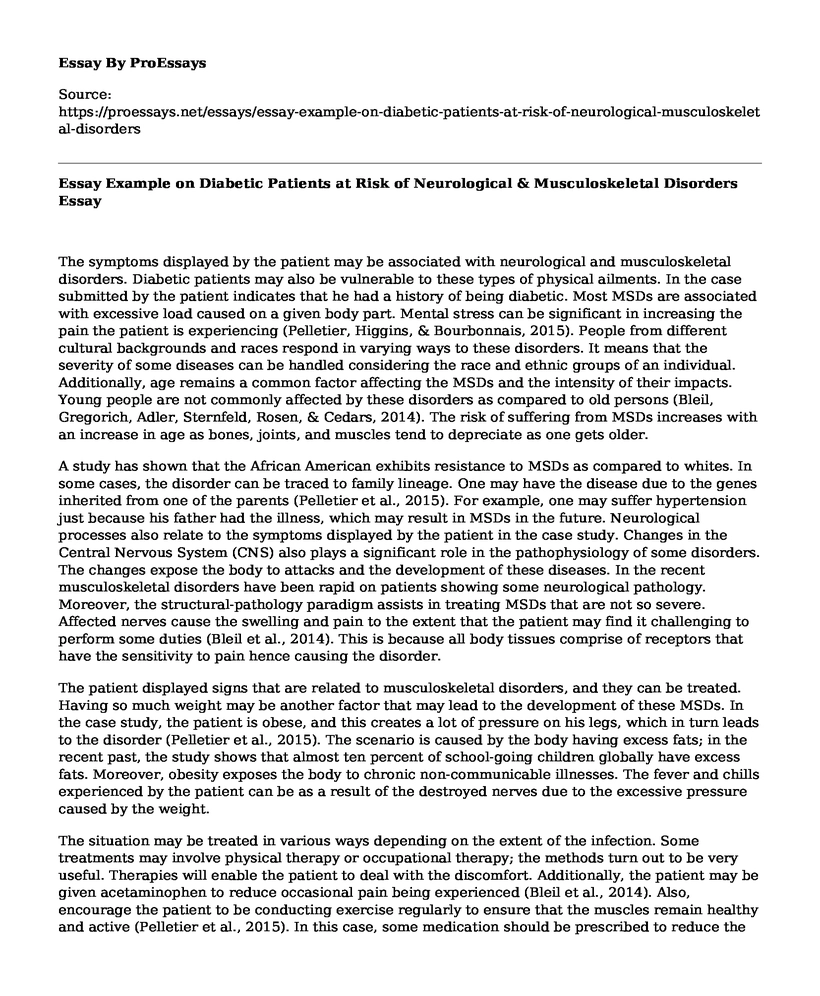The symptoms displayed by the patient may be associated with neurological and musculoskeletal disorders. Diabetic patients may also be vulnerable to these types of physical ailments. In the case submitted by the patient indicates that he had a history of being diabetic. Most MSDs are associated with excessive load caused on a given body part. Mental stress can be significant in increasing the pain the patient is experiencing (Pelletier, Higgins, & Bourbonnais, 2015). People from different cultural backgrounds and races respond in varying ways to these disorders. It means that the severity of some diseases can be handled considering the race and ethnic groups of an individual. Additionally, age remains a common factor affecting the MSDs and the intensity of their impacts. Young people are not commonly affected by these disorders as compared to old persons (Bleil, Gregorich, Adler, Sternfeld, Rosen, & Cedars, 2014). The risk of suffering from MSDs increases with an increase in age as bones, joints, and muscles tend to depreciate as one gets older.
A study has shown that the African American exhibits resistance to MSDs as compared to whites. In some cases, the disorder can be traced to family lineage. One may have the disease due to the genes inherited from one of the parents (Pelletier et al., 2015). For example, one may suffer hypertension just because his father had the illness, which may result in MSDs in the future. Neurological processes also relate to the symptoms displayed by the patient in the case study. Changes in the Central Nervous System (CNS) also plays a significant role in the pathophysiology of some disorders. The changes expose the body to attacks and the development of these diseases. In the recent musculoskeletal disorders have been rapid on patients showing some neurological pathology. Moreover, the structural-pathology paradigm assists in treating MSDs that are not so severe. Affected nerves cause the swelling and pain to the extent that the patient may find it challenging to perform some duties (Bleil et al., 2014). This is because all body tissues comprise of receptors that have the sensitivity to pain hence causing the disorder.
The patient displayed signs that are related to musculoskeletal disorders, and they can be treated. Having so much weight may be another factor that may lead to the development of these MSDs. In the case study, the patient is obese, and this creates a lot of pressure on his legs, which in turn leads to the disorder (Pelletier et al., 2015). The scenario is caused by the body having excess fats; in the recent past, the study shows that almost ten percent of school-going children globally have excess fats. Moreover, obesity exposes the body to chronic non-communicable illnesses. The fever and chills experienced by the patient can be as a result of the destroyed nerves due to the excessive pressure caused by the weight.
The situation may be treated in various ways depending on the extent of the infection. Some treatments may involve physical therapy or occupational therapy; the methods turn out to be very useful. Therapies will enable the patient to deal with the discomfort. Additionally, the patient may be given acetaminophen to reduce occasional pain being experienced (Bleil et al., 2014). Also, encourage the patient to be conducting exercise regularly to ensure that the muscles remain healthy and active (Pelletier et al., 2015). In this case, some medication should be prescribed to reduce the pain and inflammation on the toe. The MSDs can be prevented mainly by having body exercise regularly, although these may not be the complete cover for these disorders.
References
Bleil, M. E., Gregorich, S. E., Adler, N. E., Sternfeld, B., Rosen, M. P., & Cedars, M. I. (2014). Race/ethnic disparities in reproductive age: an examination of ovarian reserve estimates across four race/ethnic groups of healthy, regularly cycling women. Fertility and sterility, 101(1), 199-207. https://www.sciencedirect.com/science/article/pii/S0015028213030653
Pelletier, R., Higgins, J., & Bourbonnais, D. (2015). Is neuroplasticity in the central nervous system the missing link to our understanding of chronic musculoskeletal disorders. BMC musculoskeletal disorders, 16(1), 25.
Cite this page
Essay Example on Diabetic Patients at Risk of Neurological & Musculoskeletal Disorders. (2023, May 23). Retrieved from https://proessays.net/essays/essay-example-on-diabetic-patients-at-risk-of-neurological-musculoskeletal-disorders
If you are the original author of this essay and no longer wish to have it published on the ProEssays website, please click below to request its removal:
- Essay Sample: Smart Homes and Their Role in Home Healthcare
- King`s Conceptual System Theory Essay Example
- Abortion: Should It Be Part of Typical Practices? - Essay Sample
- Revised Paper Brings Adequate Nutrition Info to International Audience - Essay Sample
- Essay Example on Policy Measures to Protect Working-Class Group from Tuberculosis
- QlikView Hospital Activity - Report Example
- Free Essay Sample on Obesity







